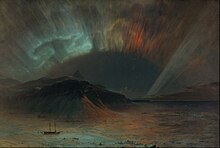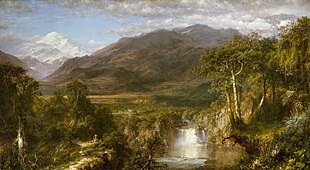弗雷德里克.埃德温Church, Frederic
弗雷德里克.埃德温Church, Frederic(1826年5月4日—1900年4月7日),美国画家。
传记
开始
弗雷德里克•埃德温教会教堂是理查德的直系后裔,一个从英国来的清教徒先锋陪同托马斯·胡克来自马萨诸塞州的原始荒野之旅将成为什么康涅狄格州哈特福德.[3]教堂是伊丽莎的儿子琼斯(nee)和约瑟夫教堂。家庭的财富来自教会的父亲,康涅狄格州的哈特福德银匠,钟表匠。撒母耳的儿子约瑟夫,反过来,是教堂,创立第一造纸厂李,马萨诸塞州的伯克郡。约瑟夫后来成为一位官员和董事安泰人寿保险公司。家庭的财富使Frederic教会追求艺术从很小的时候他的兴趣。在十八岁的时候,教堂成为了学生的托马斯·科尔[4]在卡茨基尔,纽约丹尼尔•沃兹沃思后一个家庭的邻居和创始人沃兹沃思雅典娜神庙,介绍了两个。1849年5月,教堂当选的最年轻的副教授国家设计学院和提升为院士。不久之后,他卖掉了他的第一个主要工作哈特福德的沃兹沃思阅览室.
风格
北极光(1865),史密森尼美国艺术博物馆,华盛顿特区。
教堂是第二代的产品哈德逊河学校和托马斯·科尔的学生,学校的创始人。哈德逊河学校成立由英国托马斯·科尔当他搬到美国,开始画风景,主要山脉和其他美国传统的场景。[5]科尔和教堂都是虔诚的新教徒和后者的信仰扮演了一个角色在他的画中尤其是他早期的油画。[6]科尔,还有他的朋友亚杜兰,开始在纽约这所学校,它是第一个美国艺术运动盛典。传统绘画的特征是他们关注美国田园设置,尤其是卡茨基尔山,他们浪漫的特质。这种风格试图捕捉一个不安的野生现实主义美国迅速消失,并发现和欣赏自然美景的感受。他的美国边境景观展示“扩张和乐观的经济前景在19世纪中期的美国。“教会不同于科尔在他的画作的主题:他喜欢自然和经常在科尔的倾向于寓言宏伟的场景。
热带风光(1873),布鲁克林博物馆
教堂,最喜欢第二代哈德逊河学校画家,用非凡的细节,浪漫主义,luminism在他的画中。浪漫主义是著名的英国和法国在1800年代早期作为一股对抗性的运动启蒙运动顺序和逻辑的优点。浪漫主义时期的艺术家经常在理想化的描述自然场景描绘大自然的丰富和美丽,有时也与强调大自然的宏伟规模。
El里约热内卢Luz(光之河(1877),国家美术馆的艺术
这一传统的作品进行Frederic教堂,神化一个不间断的自然,强调通过创建极其详细的艺术。强调自然是鼓励低水平线,和天空的优势提高旷野;人性,如果是代表,被描述为小相比,更自然的现实。技术技能luminism的形式,哈德逊河学校创新尤其是在教会的工作。Luminism也被认为是包括一些技术方面,可以看到在教会的工作。一个例子是试图“隐藏笔触,”这使得场景似乎更现实和减轻艺术家出现在工作。最重要的是强调光(因此luminism)在这些场景。光创造的几个来源对比图片中强调了绘画美和详细的图像。
职业生涯
科多帕希火山,1855
教会开始他的职业生涯画经典的哈德逊河学校纽约和新英格兰的场景,但到了1850年,他在纽约定居下来。教会的绘画创作方法包括在他的工作室(在寒冷、贫瘠的个月)基于草图(石油)创建的视图在夏季。在这些早些年的职业生涯中,教堂的风格使人联想到他的老师,托马斯·科尔缩影,哈德逊河学校成立的风格。教会的工作立即从科尔的关注的发散,几乎神话场景,他的早期作品却像科尔的基调。教会关注场景组成的丰富的红色,紫色,和橘子给他的工作和深度强调景观的丰富性和幻想。
安第斯山脉的(1859),大都会艺术博物馆
教堂花了两次南美,主要住在基多,厄瓜多尔1853年,第一个,第二个是在1857年。一次是由商人塞勒斯西场,他们希望利用教会的画作南美项目来吸引投资者。教堂的灵感来自于普鲁士博学的地理学家亚历山大•冯•洪堡的宇宙(关于“地球、物质和空间”)和他的大陆在1800年代早期的探索;洪堡要求艺术家描绘了安第斯山脉的“地貌”。洪堡的个人叙述后前往美国的赤道地区于1852年出版,教堂的机会去旅行,研究他的偶像的脚步(字面上的,因为他住在洪堡的老房子)在首都基多,厄瓜多尔。当教堂回到1857年,他加入他的风景画。了两趟,教会了厄瓜多尔的四个景观:厄瓜多尔的安第斯山脉(1855),卡(1858),安第斯山脉的核心(1859)和科多帕希火山(1862)。这是安第斯山脉的赢得了教会的名声,当它在1859年首次亮相。基多画画几个元素的自然结合成一个理想的丛林场景。尽管拥有清晰的透视和身体,教会让每一个细节(即使是那些山的)水晶清晰的细节。此外,安第斯山脉的中心也是一个文档,每一个存在的自然特性的科学研究在这一领域的安第斯山脉。每一个种类的植物和动物都是很容易被识别出来,甚至气候分带高度精确。
科多帕希火山,(1862)
这样,教会有一个独特的称赞洪堡(激发了他的旅程)以及维护他的哈德逊河学校根源。“因此而不是激烈的品种,橘子的情感朦胧的场景,这里的调色板是相对克制的教会的标准:安静的绿色,蓝色,褐色,赭石和柔和的灰色紫色天空,石头,翠绿和水,甚至白天。”[7]1859年,教会最终显示安第斯山脉的核心在纽约市。教会有设置展览像房子,与这幅画在窗口眺望着安第斯山脉的一部分。他完成了厄瓜多尔植物从他的旅行和一个框架和窗帘的观众(坐在长凳)透过提高效果。教堂惊讶公开公布了这幅画纽约在1859年。这幅画的框架已吸引窗帘安装,创建一个视图的窗口的假象。观众坐在长凳上查看块和教堂战略昏暗的房间里,但也突出了山水画。教会也把工厂从过去的南美之行提高观众的体验。公众被指控住院和提供歌剧眼镜检查这幅画的细节。工作是一个即时的成功。教会最终以10000美元的价格卖了它,当时的最高成交价工作一个活生生的美国艺术家。在内战期间,教会了油漆“我们的旗帜在空中”,从平版印刷是和卖给联盟士兵的家庭受益。[8]1863年,他当选的副研究员美国艺术和科学院在。[9]
的大都会艺术博物馆在纽约展出安第斯山脉的核心在1995年至96年在原坐标系,连同许多支持教会了他的史诗的研究安第斯旅程。美国人很快开始考虑教堂”米开朗基罗景观艺术”,他成为了美国最著名的艺术家之一。教堂的一部分的吸引力是事实,他反对美国艺术家的“常态”天拒绝去欧洲,大多数艺术家一样训练,而不是他的努力和天赋关注南美。这是部分由于洪堡的影响力,但也是一个有意识的决定在教堂的一部分获得名声。此外,教会最非凡的成就之一是他的商业上的成功。教会的艺术是非常有利可图的,据报道他是在他死后,价值约一百万美元今天约1250万美元。美国人迷恋教堂的代表美国的吸引力和杰出的作品。教会他的艺术展出美国艺术联盟,波士顿艺术俱乐部(最令人印象深刻的是一位年轻的艺术家)国家设计学院。他加入了他的同时代人在哈德逊河学校:托马斯·科尔,布朗亚杜兰,约翰·f·Kensett,碧玉f . Cropsey.
家庭
大厦在火山,2006年
1860年,教会买了一个农场纽约哈德逊和伊莎贝尔结婚肉体。教会的第一个儿子和女儿的死于1865年3月白喉,但他和他的妻子开始一个新的家庭诞生的弗雷德里克·约瑟夫在1866年。当他和他的妻子有一个四口之家的孩子,他们开始一起旅行。1867年,他们参观了欧洲和中东,让教堂回到绘画更大的工作。[10]
在那次旅行离开之前,教堂买下了18英亩(73000 m²)上面的山顶哈德逊农田他一直想要的,因为它华丽的的观点哈德逊河和卡茨基尔。1870年,他开始Persian-inspired大厦的建筑在山顶上和家庭搬进了家庭在1872年的夏天。理查德·莫里斯狩猎架构师在舒适的小屋吗火山,[4]并咨询在大厦的计划,但在教堂的欧洲之旅,现在的黎巴嫩、以色列、巴勒斯坦、叙利亚、约旦、和埃及,出生于英国,美国建筑师卡尔弗特沃克斯被雇来完成项目。[4]教堂深入参与的过程,甚至完成自己的建筑草图的设计。这种高度的个人和折衷的城堡合并的许多设计理念,他获得了在他旅行。
从大厦的哈德逊
疾病影响了教会的输出。尽管他作为一个艺术家非常成功,到1876年,教堂受损类风湿性关节炎大大降低了他的绘画能力。他最终用左手作画并继续产生他的工作,虽然速度慢得多。他把他的大部分能量在他生命的最后二十年他的房子在火山。
Biography
Beginnings
Frederic Edwin Curch was a direct descendant of Richard Church, who was a Puritan pioneer from England who accompaniedThomas Hooker on the original journey through the wilderness from Massachusetts to what would become Hartford, Connecticut.[3] Church was the son of Eliza (née Janes) and Joseph Church. The family's wealth came from Church's father, a silversmith and watchmaker in Hartford, Connecticut. Joseph, in turn, was the son of Samuel Church, who founded the first paper mill in Lee, Massachusetts in the Berkshires. Joseph later became an official and a director of The Aetna Life Insurance Company. The family's wealth allowed Frederic Church to pursue his interest in art from a very early age. At eighteen years of age, Church became the pupil of Thomas Cole[4] in Catskill, New York after Daniel Wadsworth, a family neighbor and founder of the Wadsworth Athenaeum, introduced the two. In May 1849, Church was elected as the youngest Associate of the National Academy of Design and was promoted to Academician the following year. Soon after, he sold his first major work to Hartford's Wadsworth Athenaeum.
Style
Church was the product of the second generation of the Hudson River School and the pupil of Thomas Cole, the school’s founder. The Hudson River School was established by the British Thomas Cole when he moved to America and started painting landscapes, mostly of mountains and other traditional American scenes.[5] Both Cole and Church were devout Protestants and the latter's beliefs played a role in his paintings especially his early canvases. [6] Cole, along with his friend Asher Durand, started this school in New York; it was the first well-acknowledged American artistic movement. The paintings were characterized by their focus on traditional American pastoral settings, especially the Catskill Mountains, and their romantic qualities. This style attempted to capture the wild realism of an unsettled America that was quickly disappearing, and the feelings of discovery and appreciation for natural beauty. His American frontier landscapes show the "expansionist and optimistic outlook of the United States in the mid-nineteenth century." Church did differ from Cole in the topics of his paintings: he preferred natural and often majestic scenes over Cole's propensity towards allegory.
Church, like most second generation Hudson River School painters, used extraordinary detail, romanticism, and luminism in his paintings. Romanticism was prominent in Britain and France in the early 1800s as a counter-movement to the Enlightenment virtues of order and logic. Artists of the Romantic period often depicted nature in idealized scenes that depicted the richness and beauty of nature, sometimes also with emphasis on the grand scale of nature.
This tradition carries on in the works of Frederic Church, who idealizes an uninterrupted nature, highlighted by creating excruciatingly detailed art. The emphasis on nature is encouraged by the low horizontal lines, and preponderance of sky to enhance the wilderness; humanity, if it is represented, is depicted as small in comparison with the greater natural reality. The technical skill comes in the form of luminism, a Hudson River School innovation particularly present in Church's works. Luminism is also cited as encompassing several technical aspects, which can be seen in Church’s works. One example is the attempt to “hide brushstrokes,” which makes the scene seem more realistic and lessen the artist’s presence in the work. Most importantly is the emphasis on light (hence luminism) in these scenes. The several sources of light create contrast in the pictures that highlights the beauty and detailed imagery in the painting.
Career
Church began his career by painting classic Hudson River School scenes of New York and New England, but by 1850, he had settled in New York. Church’s method consisted of creating paintings in his studio (in the cold, barren months of the year) based on sketches (some in oil) created of views in the summer months. In these earlier years of his career, Church’s style was reminiscent of that of his teacher, Thomas Cole, and epitomized the Hudson River School’s founding styles. Church’s work was immediately divergent from Cole’s focus on ethereal, almost mythological, scenes, but his early work did resemble Cole’s tone. Church focused on scenes composed of rich reds, purples, and oranges to give depth to his work and emphasize the richness and fantasy of the scenery.
Church took two trips to South America, and stayed predominantly in Quito,Ecuador, the first in 1853 and the second in 1857. One trip was financed by businessman Cyrus West Field, who wished to use Church's paintings to lure investors to his South American ventures. Church was inspired by the Prussian polymath geographer Alexander von Humboldt's Cosmos (about “the Earth, matter, and space”) and his exploration of the continent in the early 1800s; Humboldt had challenged artists to portray the "physiognomy" of the Andes. After Humboldt’s Personal Narrative of Travels to the Equinoctial Regions of America was published in 1852, Church jumped at the chance to travel and study in his icon’s footsteps (literally, as he stayed in Humboldt’s old house) in Quito, Ecuador. When Church returned in 1857 he added to his landscape paintings of the area. After both trips, Church had produced four landscapes of Ecuador:The Andes of Ecuador (1855), Cayambe (1858), The Heart of the Andes (1859), and Cotopaxi(1862). It was the Heart of the Andes that won Church fame when it debuted in 1859. The painting pictures several elements of Quito’s nature combined into an idealistic portrait of a jungle scene. Despite having clear perspective and foreshortening, Church keeps every detail (even those of the mountains in the back) in crystal clear detail. In addition, The Heart of The Andes is also a documentation, a scientific study of every natural feature that exists in that area of the Andes. Every species of plant and animal is readily identifiable; even climatic zonation by altitude is delineated precisely.
In this way, Church pays a unique tribute to Humboldt (who inspired his journey) as well as maintains his Hudson River School roots. “Therefore instead of the fiery crimsons and oranges of his emotional crepuscular scenes, the palette here is comparatively restrained by Church's standards: quiet greens, blues, browns, ochres and subdued grayish purples of sky, stone, verdure and water in full, even daylight.”[7] It was in 1859 that Church finally showed The Heart of the Andes in New York City. Church had set up the exhibit like a house, with the painting playing the part of a window looking out over the Andes. He completed the look with Ecuadorian plants from his travels and a frame and curtains which the audience (sitting on benches) looked through to enhance the effect. Church unveiled the painting to an astonished public in New York City in 1859. The painting's frame had drawn curtains fitted to it, creating the illusion of a view out of a window. The audience sat on benches to view the piece and Church strategically darkened the room, but spotlighted the landscape painting. Church also brought plants from a past trip to South America to heighten the viewers' experience. The public were charged admission and provided with opera glasses to examine the painting's details. The work was an instant success. Church eventually sold it for $10,000, at that time the highest price ever paid for a work by a living American artist. During the Civil War, Church was inspired to paint "Our Banner in the Sky", from which a lithograph was made and sold to benefit the families of Union soldiers. [8] In 1863, he was elected an Associate Fellow of the American Academy of Arts and Sciences in.[9]
The Metropolitan Museum of Art in New York City exhibited The Heart of the Andes in its original frame in 1995-96, together with a number of the supporting studies that Church made on his epic Andean journey. Americans soon began to consider Church the “Michelangelo of Landscape Art” and he became one of the most renowned American artists. Part of Church’s appeal was the fact that he had resisted the American artist “norm” of the day by refusing to go to Europe, as most artists did to train, instead focusing his efforts and talents on South America. This was in part due to Humboldt's influence, but was also a conscious decision on Church’s part to gain notoriety. In addition, one of Church’s most extraordinary accomplishments was his commercial success. Church’s art was extremely lucrative, he was reported to be worth approximately half-a-million dollars at his death, about 12.5 million dollars today. Americans were enamored with Church’s all-American appeal and brilliant body of work. Church exhibited his art at the American Art Union, the Boston Art Club, and (most impressively for a young artist) the National Academy of Design. He joined his contemporaries in the Hudson River School: Thomas Cole, Asher Brown Durand, John F. Kensett, and Jasper F. Cropsey.
Family
In 1860, Church bought a farm in Hudson, New York and married Isabel Carnes. Both Church's first son and daughter died in March 1865 of diphtheria, but he and his wife started a new family with the birth of Frederic Joseph in 1866. When he and his wife had a family of four children, they began to travel together. In 1867, they visited Europeand the Middle East, allowing Church to return to painting larger works.[10]
Before leaving on that trip, Church purchased the eighteen acres (73,000 m²) on the hilltop above his Hudson farmland he had long wanted because of its magnificent views of the Hudson River and the Catskills. In 1870, he began the construction of a Persian-inspired mansion on the hilltop and the family moved into the home in the summer of 1872.Richard Morris Hunt was the architect for Cosy Cottage at Olana,[4] and was consulted early on in the plans for the mansion, but after the Churches' trip to Europe and what is now Lebanon, Israel, Palestine, Syria, Jordan, and Egypt, the English-born, American architect Calvert Vaux was hired to complete the project.[4] Church was deeply involved in the process, even completing his own architectural sketches for its design. This highly personal and eclectic castle incorporated many of the design ideas that he had acquired during his travels.
Illness affected Church's output. Although he was enormously successful as an artist, by 1876, Church was stricken with rheumatoid arthritis which greatly reduced his ability to paint. He eventually painted with his left hand and continued to produce his work, although at a much slower pace. He devoted much of his energies during the final 20 years of his life to his house at Olana.
艺术官网信息声明
1、本站美术网信息均来自于美术家自己或其朋友、网络等方式,本站无法确定每条信息或事件的真伪,仅做浏览者参考。
2、只要用户使用本站则意味着该用户以同意《本站注册及使用协议》,否则请勿使用本站任何服务。
3、信息删除不收任何费用,VIP会员修改信息终身免费(VIP会员点此了解)。
4、未经本站书面同意,请勿转载本站信息,谢谢配合!
- 阿尔贝托·瓦尔加斯Alberto Vargas
- 尼古拉·费申
- 惠斯勒
- 波洛克 Pollock Jackson
- 莱斯利John Leslie Breck
- 约翰·詹姆斯·奥杜邦John James Audubon
- 列维威尔斯普伦蒂斯Levi Wells Prentice
- 奥格登明顿普莱斯纳 Ogden Pleissner
- 保罗·阿克曼Paul Ackerman
- 帕特里夏Patricia Watwood
- 纳尔逊.尚克斯Nelson Shanks
- 理查德·米勒Richard E. Miller
- 马克斯菲尔德.帕里什Maxfield Parrish
- 莫里斯·普伦德加斯特Maurice Prendergast
- 玛丽·卡萨特Mary Cassatt
- 马斯登.哈特利Marsden Hartley
- 基思.帕金森Keith Parkinson
- 约瑟夫· 德坎普Joseph DeCamp
- 约瑟夫·克里斯蒂安Joseph Christian
- 约瑟夫·阿尔伯斯Josef Albers
- 约翰·亚历山大·怀特John White Alexander
- 约翰.范德林John Vanderlyn
- 约翰·亨利·特瓦克特曼John Henry Twachtman
- 萨金特(John singer sargent)



















